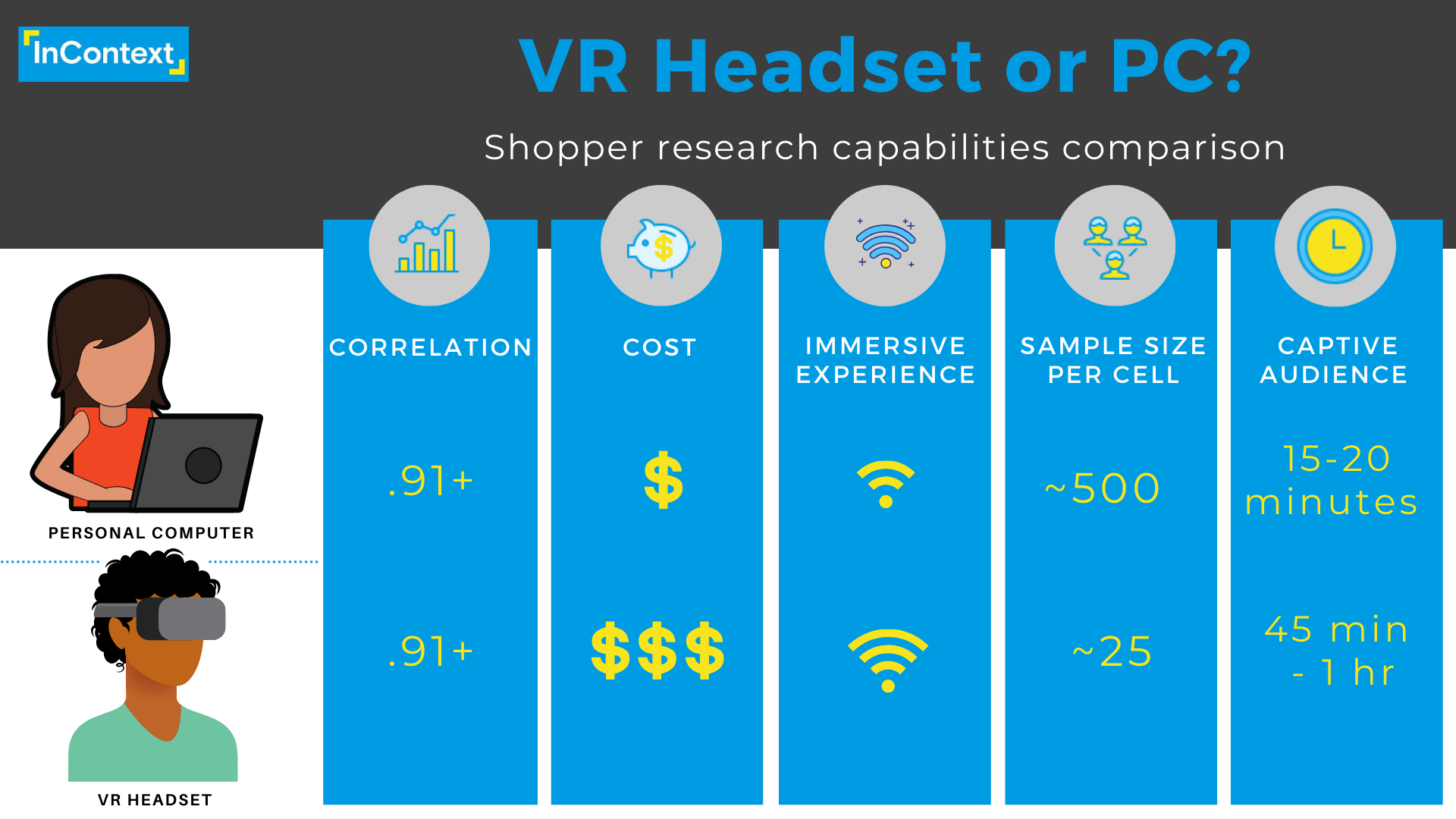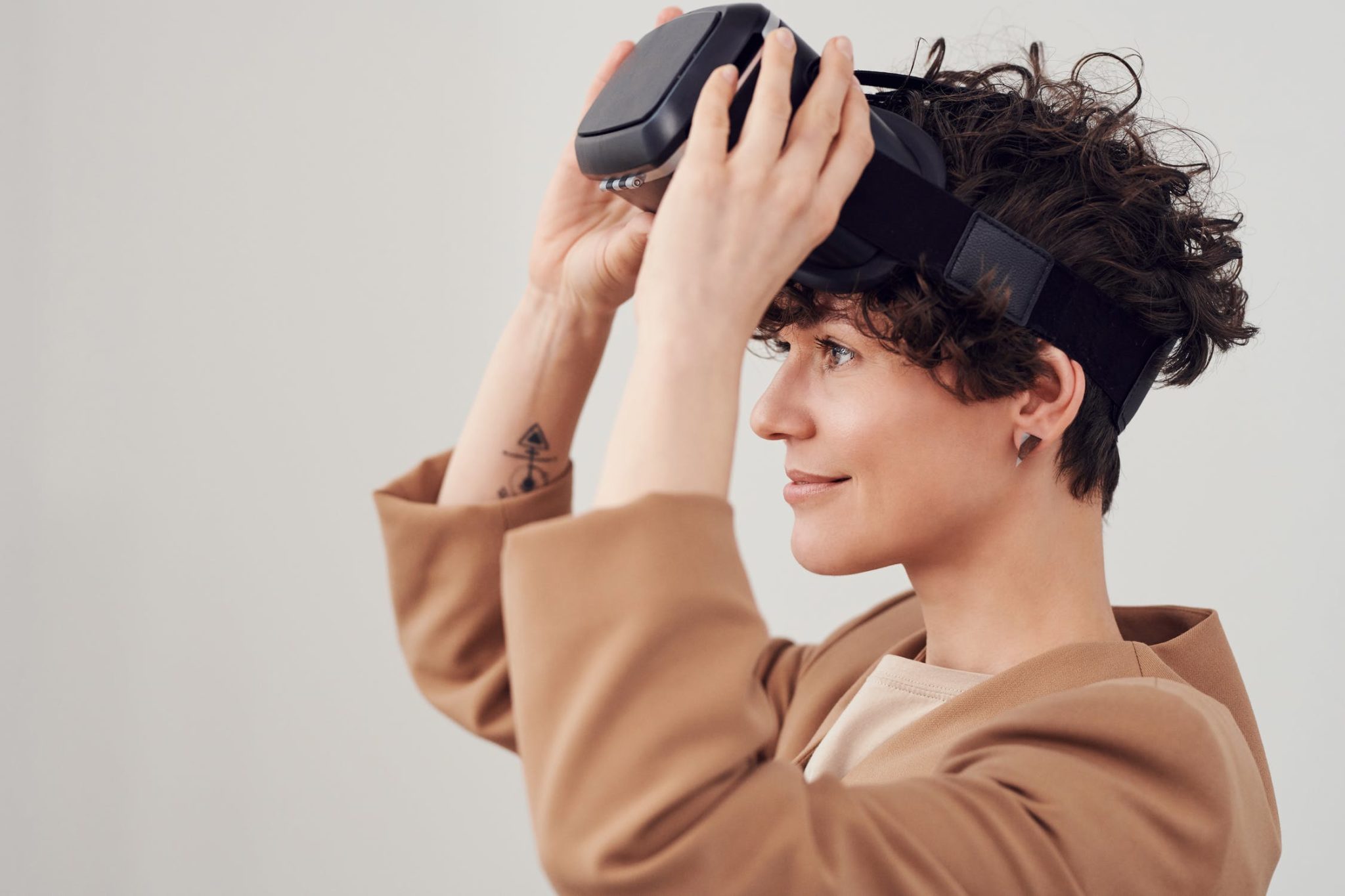There are two different, yet common, responses when people inquire about virtual shopper research:
“Awesome, I’ve always wanted to see how our retail environments look with VR googles on!” or “Do I have to wear one of those giant headsets for this?”
Both are valid reactions. Today, many retail teams are opting to use virtual simulations to mirror their real life shelves and products in order to learn how shoppers will react in a risk-free space—but they understandably have questions about how VR works in this context.
Virtual retail technology allows for the creation of “digital twin” stores spaces, and nearly any kind of shopping behavior testing that you might think of doing in a store can be replicated virtually, unlike traditional market research. This includes:
Shelf concepts – create multiple assortment or arrangement concepts, visualize and compare them, and test them out with real shoppers in a simulated shopper exercise.
Signage and package design – instead of spending time and resources (ie. dollars) on new in-store marketing materials, test them first in a risk-free space to help predict ROI. Similarly, test new product or package design changes in a virtual environment before going to production.
Out of stock substitutions – especially in today’s climate, it’s important to understand when shoppers are willing to replace an item when it is not available, and when they will walk away instead.
Macro-space planning – store layout is just as important as the shelf. Shoppers need to be able to navigate the aisles in a way that makes sense, allows for discovery of new SKUs and brands, and reduces confusion. As we know, the longer it takes to find a product, the smaller the basket size.
Leveraging virtual shopper insights enables you to bring a winning concept to market faster, and lets you avoid the risk of pricey mistakes.
But back to how it works: many people would rather not have to don somewhat cumbersome VR goggles. Others love the idea of being immersed in a completely simulated space and want that added experience for their teams. The good news is you have choices.
HMD Vs. PC
A virtual head-mounted device (HMD) is what many just call VR goggles or headsets. When you think of virtual reality video games, this is what you probably picture. Wearing a HMD means you are fully immersed in a virtual world. You can look and walk all around the hyper-realistic 3D scenes and feel like you really exist in that space.
But, virtual simulations work on a PC as well. This requires no gear, just a wifi connection and computer. This partially immersive method lets you “walk” around and view the exact same hyper-realistic environment as above, without being completely cut off from the real world. Your view is what you see on your monitor.
At InContext, this is the method we generally use for our clients. We’ll explain why, below.

When it comes to shopper research, both methods have their place. Let’s break down the pros and cons for the two different methods:
HMD
Pros
- More immersive – by far the number one reason to use an HMD is to feel like you are fully present in a store environment or shelf simulation. It is the most immersive way to interact with a virtual store.
- Captive Audience Attention – HMDs can provide 2-3x the mission duration than traditional web-based surveys, because they generate a more unique and novel experience than the average survey respondent gets. These customer experience tests generally take place in a central location with higher rewards incentives as well, leading to an expected higher interview length. This allows for multiple category shopping or longer way-finding methodologies that can answer more complex questions.
- High correlation to the real world – shoppers behave just as they would in a physical world shopping trip, with correlations at .96 when compared against physical store tests.
Cons
- Limited sample size – HMDs are not yet ubiquitous, so most consumers today do not already own their own virtual reality goggles. You could run these tests in the homes of those that do have a headset but very few brands or retailers consider video gamers their only audience. The leads to central location testing where sample sizes are much lower, more costly and more time consuming.
- Expensive – The price of VR headsets have come down in the last decade, but they are still expensive, and require more expensive computers to run them. Their central location nature of testing adds substantial cost as well.
- Lengthy training – Training someone to use VR headsets can be time-consuming, especially for someone who has no prior experience with virtual.
PC
Pros
- Large sample size – everyone has a PC, so the pool of shoppers to conduct research from is massive, in the multi-millions.
- Both quantitative and qualitative data – Because focus group size is large and dynamic, this method allows for both quantitative shopper data, as well as qualitative—we can gather attitudinal feedback from shoppers to learn why they behaved as they did in the simulation.
- Cost-effective – running virtual simulations on a PC requires common computer equipment that most people have in their homes today, and modest bandwidth requirements. No expensive gear needed.
- High correlation to the real world – shoppers behave just as they would in a physical world shopping trip, again at that .96 when compared against physical store tests.
Cons
- Smaller study areas – PC testing is ideally suited for single-category shopping missions where the respondent is in and out in 5-8 minutes.
So, which one is better?
Here’s the big takeaway: While both shopping research techniques produce data that correlates highly with the physical world, right now PC testing is the most cost-effective and efficient option. The added expense and time to conduct in-person HMD tests is not usually necessary, since it yields nearly identical results.
For example, one retailer’s category management captain wanted to improve penetration, while also growing category sales, by creating a new shelf arrangement. They turned to cloud-based virtual research to quickly test multiple concepts before going to market:
-
The captain worked with a category buyer to come up with two different shelf arrangements.
-
These versions were then tested against each other as well as against the current concept with real shoppers in a virtual shopping environment on their PCs.
-
While the category captain’s version was shown to have increased penetration, it did not fare as well as the buyer’s version when it came to improved sales. Therefore the winning concept was implemented and resulted in $920K in incremental sales and $275K in category margin for the retailer.
-
This case study was all done without the need for immersive VR goggles or equipment.
That said, if you’re looking to field a multi-category shelf or aisle, or a large-store test, an in-person HMD test might be what you’re looking for. The market is nearing a point where untethered headsets are starting to become pervasive in homes, and InContext is currently working on ways to take advantage of the rise in personal HMD use, creating completely immersive methodologies that still mirror the price and timing of virtual testing via PC.
For now, if you’re interested in virtual shopper research and how it can help your in-store decision making, just know you don’t have to put on VR goggles — unless you want to.





